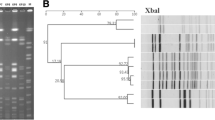Summary
We report on nosocomial infections caused bySerratia marcescens occurring in a neonatal intensive care unit and a children's ward for cardiac intensive care. According to the plasmid pattern analysis, all isolated epidemic strains belonged to one clone. Multidrug resistance, even to cephalosporins of the third generation and amikacin, was characteristic for all strains. Certain markers ofS. marcescens (haemolysin, proteases, siderophores) which are thought to be related to virulence were studied but will require further investigation.
Zusammenfassung
Es wird über nosokomiale Infektionen durchSerratia marcescens auf einer neonatologischen Intensivtherapiestation und einer pädiatrisch-kardiologischen Überwachungsstation berichtet. Nach der Plasmidmusteranalyse gehören die isolierten Stämme einem Epidemieklon an. Charakteristisch für alleS. marcescens-Stämme ist eine Multiresistenz, auch gegen Cephalosporine der dritten Generation und Amikacin. Bestimmte Merkmale der Infektionserreger (Hämolysin, Protease, Siderophore), die mit der Virulenz in Zusammenhang gebracht werden, bedürfen weiterer Untersuchungen.
Similar content being viewed by others
References
Baumann, U., Emmrich, P. Sepsis und andere Infektionen durchSerratia marcescens im Neugeborenen- und Säuglingsalter. Dtsch. Med. Wochenschr. 99 (1974) 1775–1760.
Handrick, W., Bergmann, L., Spencker, F. B. Perinatale Infektionen durch seltene Erreger. 2.Serratia marcescens. Pädiatrie 20 (1981) 87–93.
Taylor, P. W., Roberts, A. W., Gower, P. E. Evaluation of a technique for the estimation of serum bactericidal activity against gram-negative organisms. Med. Lab. Technol. 29 (1972) 272–279.
Reissbrodt, R., Rabsch, W. Further differentiation of Enterobacteriaceae by means of siderophore-pattern analysis. Zbl. Bakt. Hyg. A 268 (1988) 306–317.
Adegbola, R. A., Old, D. C. New fimbrial hemagglutinin inSerratia species. Infect. Immun. 38 (1982) 306–315.
Lindahl, M., Faris, A., Wadström, T., Hjerten, S. A new test, based on “salting out” to measure relative surface hydrophobicity of bacterial cells. Biochim. Biophys. acta 677 (1981) 471–476.
Klare, I., Witte, W. Mikrobouillonverdünnungstest zur standardisierten Bestimmung minimaler Hemm- und bakterizider Konzentrationen antimikrobieller Chemotherapeutika bei schnellwachsenden aeroben Bakterien. Z. ges. Hygiene 34 (1988) 111–115.
Klare, I., Witte, W. Methoden des Betalactamase-Nachweises bei Bakterien. Z. ges. Hygiene 30 (1984) 442–449.
Kado, C., Liu, S. T. Rapid procedure for detection and isolation of large and small plasmids. J. Bacteriol. 145 (1981) 1365–1373.
Achtmann, M., Mercer, A., Kusecek, B., Pohl, A., Heuzenroeder, M., Aaronson, W., Sutton, A., Silver, R. P. Six widespread bacterial clones amongEscherichia coli isolates. Infect. Immun. 39 (1983) 315–335.
Halle, E., Klare, I., Grauel, E. L., Bollmann, R., Baumann, B., Buchholz, P., Witte, W., Göldner, R.: Nosokomiale Infektionen durch Serratia marcescens in einem Universitätsklinikum. Pädiatr. Grenzgeb. 28 (1989) (in press).
Witte, W., Spencker, F.-B., Halle, E. Überregionale Studie zur Chemotherapeutikaresistenz bei bakteriellen Infektionserregern. Z. Klin. Med. 42 (1986) 31–36.
Aspiotits, A., Cullmann, W., Dick, W., Stieglitz, M. Inducible betalactamases are principally responsible for the naturally occurring resistanee towards betalactam-antibiotics inProteus vulgaris. Chemotherapy 32 (1986) 236–246.
Lindberg, F., Normark, S. Contribution of chromosomal betalactamases to betalactam resistance in enterobacteria. Rev. Infect. Dis. 8 (1986) 292–304.
Okonogi, K., Sugiura, A., Kuno, M., Higashide, E., Kondo, M., Imada, A. Effect of betalactamase induction on susceptibility to cephalosporins inEnterobacter cloacae andSerratia marcescens. J. Antimicrob. Chemother. 16 (1985) 31–42.
Seeberg, A. H., Toxdorff-Neutzling, R. M., Wiedemann, B. Chromosomal betalactamases ofEnterobacter cloacae are responsible for resistance to third-generation cephalosporins. Antimicrob. Agents Chemother. 23 (1983) 918–925.
Wiedemann, B., Korfmann, G.: Selection of mutants resistant to betalactam drugs. Proceedings IXth International Congress of Infections and parasitic diseases, Munich, July 20–26, 1986 p. 135–139.
Vu, H., Nikaido, H. Role of betalactam hydrolysis in the mechanism of resistance of a betalactamase-constitutive strain to expanded spectrum betalactams. Antimicrob. Agents Chemother. 27 (1985) 393–398.
Sanders, C. C. Inducible betalactamases and nonhydrolytic resistance mechanism. J. Antimicrob. Chemother. 13 (1984) 1–3.
Olson, B., Weinstein, R. A., Nathan, C., Kabins, S. A. Broad spectrum betalactam resistance inEnterobacter: Emergence during treatment and mechanism of resistance. J. Antimicrob. Chemother. 11 (1983) 299–310.
Then, R. L., Angehrn, P. Trapping of nonhydrolyzable cephalosporins by cephalosporinases inEnterobacter cloacae andPseudomonas aeruginosa as a possible resistance mechanism. Antimicrob. Agents Chemother. 21 (1982) 711–717.
Traub, W. H., Bauer, D. Outer membrane protein alterations inSerratia marcescens resistant against aminoglycoside and betalactam antibiotics. Chemotherapy 33 (1987) 172–176.
König, W., Faltin, Y., Scheffler, J., Schöffler, H., Braun, V. Role of a cell-bound hemolysin as a pathogenicity factor ofSerratia marcescens. Infect. Immun. 55 (1987) 2554–2561.
Poole, K., Braun, V. Iron regulation ofSerratia marcescens hemolysin gene expression. Infect. Immun. 56 (1988) 2967–2971.
Molla, A., Kagimoto, T., Maeda, H. Cleavage of immunoglobulin G (IgG) and IgA around the hinge region by proteases fromSerratia marcescens. Infect. Immun. 56 (1988) 916–920.
Traub, W. H. Virulence of nosocomial isolates ofSeratia marcescens for NMRI mice, correlation with O-antigens 06 and 014. Zbl. Bakt. Hyg. A 252 (1982) 360–369.
Author information
Authors and Affiliations
Rights and permissions
About this article
Cite this article
Bollmann, R., Halle, E., Sokolowska-Köhler, W. et al. Nosocomial infections due to serratia marcescens — Clinical findings, antibiotic susceptibility patterns and fine typing. Infection 17, 294–300 (1989). https://doi.org/10.1007/BF01650711
Received:
Accepted:
Issue Date:
DOI: https://doi.org/10.1007/BF01650711




